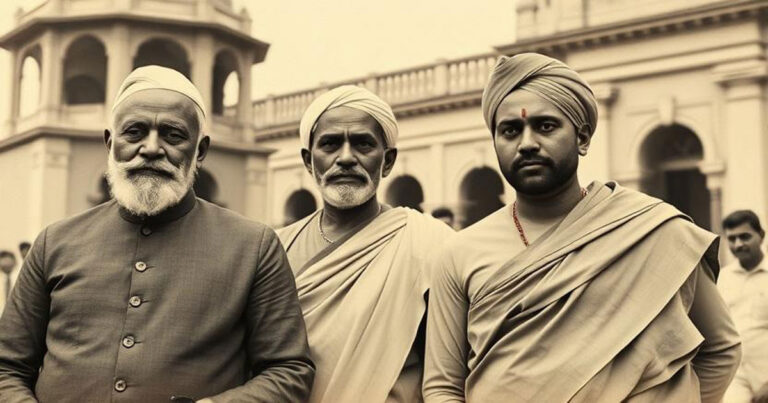When we speak of freedom, we often remember the flag, the anthem, and the national holidays. But behind those symbols lie blood, sweat, and sacrifice — of brave men and women who chose to challenge the might of an empire. This is not just history. This is legacy — a powerful wave of rebellion that stirred the soul of India.
Let us revisit the stories of India’s unsung heroes — those whose names may not always find place in textbooks, but whose courage sparked revolutions.
- 1. Bhagat Singh: The Spark That Lit a Generation
- 2. Subhas Chandra Bose: The Thunder That Roared “Give Me Blood…”
- 3. Rani Lakshmibai: The Warrior Queen Who Fought Like a Man
- 4. Mangal Pandey: The First Spark of 1857
- 5. Chandrashekhar Azad: The Shadow That Lived Free and Died Free
- Conclusion: A Legacy That Breathes in Every Indian
- Indian Revolutionaries and Freedom Struggle
1. Bhagat Singh: The Spark That Lit a Generation
Bhagat Singh was not just a revolutionary — he was a symbol of fearless youth. Born in 1907, he grew up witnessing the Jallianwala Bagh massacre. At just 23, he sacrificed his life with a smile, shouting “Inquilab Zindabad” till his final breath.
His writings, his clarity of thought, and his calm acceptance of death made him a martyr beyond time. He wasn’t fighting for revenge; he was fighting for justice and awakening.
2. Subhas Chandra Bose: The Thunder That Roared “Give Me Blood…”
Subhas Chandra Bose’s journey was nothing short of epic. Known as Netaji, he rejected comfort and position to build the Azad Hind Fauj (INA). His iconic call — “Give me blood, and I will give you freedom” — was not just a slogan, it was a heartbeat.
Unlike many, he believed in armed struggle and forged international alliances. Even today, his mystery-filled life and undying patriotism echo through history.
3. Rani Lakshmibai: The Warrior Queen Who Fought Like a Man
She was not born into war, but war was born in her. Rani Lakshmibai of Jhansi is the soul of feminine courage in India’s independence saga. In 1857, when the British tried to annex her kingdom, she chose the sword over surrender.
Clad in armor, with her child on her back, she rode into battle and became a legend — inspiring generations of women to fight for what is right.
4. Mangal Pandey: The First Spark of 1857
In 1857, Mangal Pandey, a soldier in the British East India Company’s army, fired the first shot of rebellion. His act of defiance became the ignition for the First War of Independence.
Though executed early, his name became immortal, and he remains the fire that dared to challenge British rule when few dared to speak.
5. Chandrashekhar Azad: The Shadow That Lived Free and Died Free
“I was born free and will die free.” These were the words of Chandrashekhar Azad, one of the most elusive revolutionaries of British India. Fiercely committed, deeply ideological, and a master of guerilla tactics — he died in battle by his own bullet rather than be caught.
Azad was not just a man, he was a myth, and his very name instilled fear in the British.
The Emotion Beyond History:
Reading about these freedom fighters isn’t merely education — it’s awakening. It’s where dopamine surges with pride, serotonin calms with inspiration, and adrenaline rises with courage. These stories are the soulprint of India’s identity.
They remind us: freedom is never free.
Conclusion: A Legacy That Breathes in Every Indian
We walk free today not because time passed — but because they stood still and refused to bow. Let us carry their spirit in our actions, in our thoughts, and in how we honor our nation’s soul.
Every heartbeat of India still echoes with their names.
Indian Revolutionaries and Freedom Struggle
Who was the first Indian revolutionary?
Mangal Pandey is widely regarded as the first revolutionary who sparked the 1857 uprising, known as the First War of Indian Independence.
Why is Bhagat Singh considered a hero?
Bhagat Singh’s fearless attitude, intellectual depth, and ultimate sacrifice at just 23 made him a symbol of youth resistance against British rule.
What was Subhas Chandra Bose’s contribution to India’s freedom?
Subhas Chandra Bose formed the Indian National Army (INA) and launched an armed struggle against the British, inspiring millions through his leadership and vision.
Did Rani Lakshmibai fight in battle herself?
Yes, Rani Lakshmibai personally led her troops in battle, famously riding into combat with her child strapped to her back.
What made Chandrashekhar Azad different from other freedom fighters?
Chandrashekhar Azad embraced guerrilla warfare and chose to die by his own bullet rather than be captured, symbolizing true independence.
How can students learn more about these revolutionaries?
Apart from textbooks, reading biographies, visiting historical sites, and exploring well-researched articles like this one offers deeper insights.
